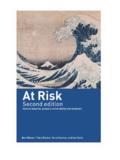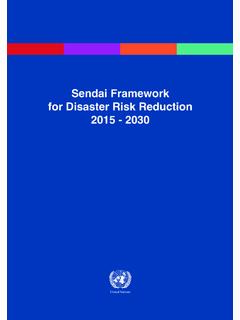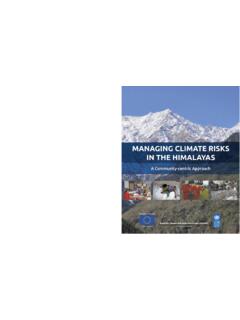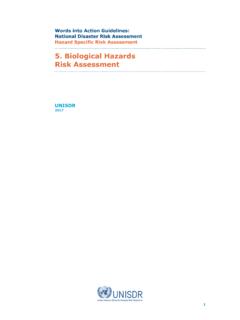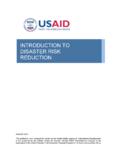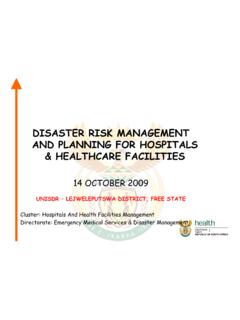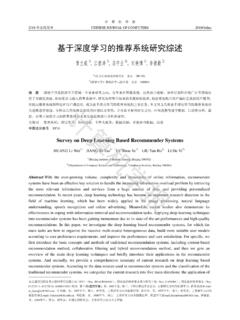Transcription of Exposure and Vulnerability - PreventionWeb
1 UNISDR Science and technology Conference on the implementation of the Sendai Framework for Disaster Risk Reduction 2015- 2030. Launching UNISDR Science and technology Partnership and the Science and technology Road Map to 2030. To promote and support the availability and application of science and technology to decision-making in Disaster Risk Reduction 27-29 January 2016. Geneva International Conference Centre Short concept note: Work Stream 2, Working Group 2. Exposure and Vulnerability 1) Overview The Sendai Framework for Disaster Risk Reduction highlights that: Policies and practices for disaster risk management should be based on an understanding of disaster risk in all its dimensions of Vulnerability , capacity, Exposure of persons and assets, hazard characteristics and the environment.
2 Such knowledge can be leveraged for the purpose of pre-disaster risk assessment, for prevention and mitigation and for the development and implementation of appropriate preparedness and effective response to disasters.. The UNISDR defines Vulnerability as the conditions determined by physical, social, economic and environmental factors or processes, which increase the susceptibility of a community to the impact of hazards (UNISDR 2009). Vulnerability may vary within a population by subgroup ( income level or type of livelihood) and may change over time, adding further complexity to Vulnerability measurement and risk estimation (Birkmann et al 2006).
3 Exposure is defined as the people, property, systems, or other elements present in hazard zones that are thereby subject to potential losses (UNISDR 2009). Thus, understanding Vulnerability and Exposure are fundamental to our understanding of risk. Together, increases in Vulnerability and Exposure dominate the overall increase in risk observed worldwide over the past several decades, and therefore require particular attention in the formulation of policies and actions to reduce disaster risk. Implementing an all-hazards approach that incorporates natural and mad-made hazards (including technological and biological hazards that can have cascading effects that transcend country boundaries) and incorporating all elements of risk will require an integrated and collaborative approach across disciplines, sectors and institutions as well as cooperation among science and technology S&T networks.
4 The Work Stream 2 Working Group on Exposure and Vulnerability ' will address how to promote a common understanding of Exposure and Vulnerability as fundamental elements of risk assessment through a partnership of the scientific community, policy makers and community representatives across disciplines and policy sectors in order to achieve the outcome of the Sendai Framework for Disaster Risk Reduction to reduce disaster losses in lives, livelihoods and health by 2030 (see Annex 1). 2) Stock taking The severity of the impacts of disasters depends strongly on the level of Exposure and Vulnerability in the affected area, and evidence indicates that risk has increased worldwide largely due to increases in the Exposure of persons and assets.
5 For example, increasing Exposure has been the major cause of long-term increases in economic losses from weather- and climate-related disasters (IPCC 2012). There have been localised reductions in Vulnerability as a result of, for instance, better building standards and compliance (as in Chile), but these reductions are geographically uneven and there are many instances of increased Vulnerability , particularly in large urban centres and in developing countries. This has created new risk and a rise in disaster losses particularly at the local and community level with the poor and marginalized, minority populations, women and children, and those dependent on single sector economies disproportionately affected (UNISDR 2015, Cutter et al 2003).
6 Both Exposure and Vulnerability are dynamic, vary across temporal and spatial scales, and depend on economic, social, geographic, demographic, cultural, institutional, governance- related, and environmental factors. Moreover, factors affecting Exposure and Vulnerability vary considerably by hazard context, disaster stage and national setting (Rufat et al 2015). High Exposure and Vulnerability are linked to skewed development processes, such as those associated with environmental mismanagement, rapid demographic changes, rapid and unplanned economic processes, urbanization in hazardous areas, poor governance, and the scarcity of livelihood options for the people particularly the poor (Cardona et al 2012).
7 Inequality also affects response and coping mechanisms putting more people at risk. Measuring Vulnerability and Exposure requires an integrated understanding of components and how these factors combine to contribute to the resilience1 of communities (Carreno et al 2007, Burton et al 2014). These approaches include methods that use predominantly statistical data gathered from published sources, and approaches which involve surveying local populations. Efforts to quantify risk have typically considered a limited number of dimensions like the physical dimension ( , buildings and mortality) and/or economic aspects of Vulnerability , but social Vulnerability is poorly understood and difficult to measure.
8 Useful approaches exist such as examining Vulnerability and its relationship to inequality in the social and health sciences and (see the Social Determinants of Health approach (WHO 2008). In most countries, vital statistical information is collected through a national census, but this information seldom incorporates information on the construction of buildings, or social demographic data vital to assessing Vulnerability of populations. Moreover, this type of statistical data is often only available at a level of geographic aggregation that makes it difficult to use effectively in risk assessments. Issues also include access to proprietary data, privacy, accuracy, consistency and lack of openness.)
9 Opportunities Significant advances have been made in using many sources of statistical data to develop Exposure models. However, the development of Exposure databases that are fit for purpose for risk assessments across geographic scales and for different hazards and types of risks represents a significant challenge. The challenge is compounded by the fact that Exposure data is multi-faceted and complex, and seldom if ever the responsibility of any one organisation to collect and maintain. An important area of research is in the development of Exposure databases from remote sensing satellites and computer-based techniques such as crowd-sourcing and drones which can provide highly accurate descriptions of population distributions and physical attributes of the natural and built environment.
10 Such approaches are even more powerful when combined with ground-based data from imagery or statistical data. Four distinct and largely independent research and policy communities disaster risk reduction, climate change adaptation, and environmental management and poverty reduction have been working to reduce Vulnerability to hazards but face challenges in terms 1. Resilience is defined as the ability of a system, community or society exposed to hazards to resist, absorb, accommodate to and recover from the effects of a hazard in a timely and efficient manner, including through the preservation and restoration of its essential basic structures and functions (UNISDR 2009).
